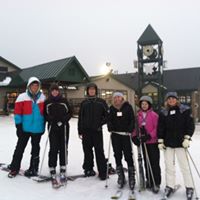Ellen R Laird
age ~70
from Saint George, UT
- Also known as:
-
- Ellen Laird Marital
- Ellen R Brumm
- Ron Laird
- Ron L Aird
- Phone and address:
- 5675 N 1180 W, Saint George, UT 84770
Ellen Laird Phones & Addresses
- 5675 N 1180 W, Saint George, UT 84770
- St George, UT
- 19040 Graystone Ln, San Jose, CA 95120
- 1000 S Idaho Rd #373, Apache Junction, AZ 85119
- Kealakekua, HI
- Captain Cook, HI
- Nevada City, CA
- Novato, CA
- Hawi, HI
Work
-
Company:Vlsi standards inc
-
Address:3087 N 1St St, San Jose, CA 95134
-
Phones:4084281800
-
Position:Coo
-
Industries:Instruments for Measuring and Testing of Electricity and Electrical Signals
Name / Title
Company / Classification
Phones & Addresses
COO
Vlsi Standards Inc
Instruments for Measuring and Testing of Elec...
Instruments for Measuring and Testing of Elec...
3087 N 1St St, San Jose, CA 95134
Us Patents
-
Line Width Calibration Standard Manufacturing And Certifying Method
view source -
US Patent:6358860, Mar 19, 2002
-
Filed:Feb 2, 2000
-
Appl. No.:09/496884
-
Inventors:Bradley W. Scheer - San Jose CA
Ellen R. Laird - San Jose CA -
Assignee:VLSI Standards, Inc. - San Jose CA
-
International Classification:H01L 21302
-
US Classification:438745, 438753, 438756
-
Abstract:A method of making and certifying submicron line width calibration standards includes steps of thermal growth of a silicon dioxide film layer on top and vertical side wall surfaces of silicon regions, e. g. strips or mounds, that are formed over a silicon dioxide layer on a silicon substrate, then optically measuring the top film layer thickness, removing the oxide film from the top surface of the silicon regions via a planarization technique that protects the film on the side walls, and finally removing at least some, and in most cases preferably all, of the silicon material to leave just the oxide film that was on the side walls of the former silicon regions as submicron linear features, such as extended isolated lines or connected line segments arranged in a polygon. The width of these linear features is certifiable via cross-section testing of samples that have been formed by the film layer growth by means of scanning electron or atomic force microscopy to obtain a ratio of top-to-side film thicknesses, so that the lines on the standard are determined to have widths calculated from that ratio and the optically measured top film thickness. In an alternate embodiment, an atomic force microscope probe tip determining standard can be made using the same formation steps as the line width standard except that a silicon layer with [100] top surface instead of [ ] top surface for the line width standard is used.
-
Submicron Dimensional Calibration Standards And Methods Of Manufacture And Use
view source -
US Patent:6646737, Nov 11, 2003
-
Filed:Sep 24, 2001
-
Appl. No.:09/961629
-
Inventors:Marco Tortonese - Mountain View CA
Ian Smith - Los Gatos CA
Ellen Laird - San Jose CA
Bradley W. Scheer - San Jose CA -
Assignee:KLA-Tencor Technologies - Milpitas CA
-
International Classification:G01R 3126
-
US Classification:3562434, 3562431, 438 14
-
Abstract:A calibration standard which may be used to calibrate lateral dimensional measurement systems is provided. The calibration standard may include a first substrate spaced from a second substrate. In addition, the calibration standard may include at least one layer disposed between the first and second substrates. The layer may have a traceably measured thickness. For example, a thickness of the layer may be traceably measured using any measurement technique in which a measurement system may be calibrated with a standard reference material traceable to a national testing authority. The calibration standard may be cross-sectioned in a direction substantially perpendicular to an upper surface of the first substrate. The cross-sectioned portion of the calibration standard may form a viewing surface of the calibration standard. In this manner, a lateral dimensional artifact of the calibration standard may include the traceably measured thickness of at least the one layer.
-
Dimensional Calibration Standards
view source -
US Patent:7301638, Nov 27, 2007
-
Filed:Jan 31, 2004
-
Appl. No.:10/770151
-
Inventors:Marco Tortonese - Mountain View CA, US
Jerry Prochazka - Clayton CA, US
Ellen Laird - San Jose CA, US
Pat Brady - Livermore CA, US
Rene M. Blanquies - San Jose CA, US -
Assignee:KLA Tencor, Inc. - San Jose CA
-
International Classification:G01N 21/84
-
US Classification:356430, 3562431
-
Abstract:A calibration standard, for calibrating lateral or angular dimensional measurement systems, is provided. The standard may include a first substrate spaced from a second substrate. The standard may be cross-sectioned in a direction substantially perpendicular or substantially non-perpendicular to an upper surface of the first substrate. The cross-sectioned portion of the standard may form a viewing surface of the calibration standard. The standard may include at least one layer disposed between the first and second substrates. The layer, or a feature etched into the first or second substrate or a feature etched into the layer may have a traceably measured thickness or may be oriented at a traceably measured angle with respect to the viewing surface. A thickness or angle of the layer or other feature may be traceably measured using any technique for calibrating a measurement system with a standard reference material traceable to a national testing authority.
-
Dimensional Calibration Standards
view source -
US Patent:7453571, Nov 18, 2008
-
Filed:Nov 27, 2007
-
Appl. No.:11/945871
-
Inventors:Marco Tortonese - Mountain View CA, US
Jerry Prochazka - Clayton CA, US
Ellen Laird - San Jose CA, US
Pat Brady - Livermore CA, US
René M. Blanquies - San Jose CA, US -
Assignee:KLA-Tencor Corporation - San Jose CA
-
International Classification:G01N 21/84
-
US Classification:356430, 3562431
-
Abstract:A calibration standard, for calibrating lateral or angular dimensional measurement systems, is provided. The standard may include a first substrate spaced from a second substrate. The standard may be cross-sectioned in a direction substantially perpendicular or substantially non-perpendicular to an upper surface of the first substrate. The cross-sectioned portion of the standard may form a viewing surface of the calibration standard. The standard may include at least one layer disposed between the first and second substrates. The layer, or a feature etched into the first or second substrate or a feature etched into the layer may have a traceably measured thickness or may be oriented at a traceably measured angle with respect to the viewing surface. A thickness or angle of the layer or other feature may be traceably measured using any technique for calibrating a measurement system with a standard reference material traceable to a national testing authority.
-
Formation Of Atomic Scale Vertical Features For Topographic Instrument Calibration
view source -
US Patent:55994644, Feb 4, 1997
-
Filed:Oct 6, 1995
-
Appl. No.:8/539973
-
Inventors:Ellen R. Laird - San Jose CA
W. Murray Bullis - Sunnyvale CA
James J. Greed - Los Gatos CA
Bradley W. Scheer - San Jose CA -
Assignee:VLSI Standards, Inc. - San Jose CA
-
International Classification:C03C 1500
-
US Classification:216 2
-
Abstract:A calibration target for topographic inspection instruments, operating at sub-micrometer resolution levels, having features on the order of 10 Angstroms in vertical height, an atomic scale distance. The features are formed on a silicon substrate, such as a wafer, by deposition of a thick oxide, such as a typical thermal oxide, over the wafer surface. A pattern of features is patterned and etched to the level of raw silicon at the wafer surface. Areas which have been etched are converted to a thin oxide, which slightly lowers the level of silicon in these areas. All oxide is removed and the slightly lower level of silicon gives rise to features having atomic scale vertical topographic dimensions. Millions of such features are produced simultaneously on a wafer to mimic the effect of haze or micro-roughness on a polished wafer.
-
Method For Calibrating A Topographic Instrument
view source -
US Patent:56777655, Oct 14, 1997
-
Filed:Aug 16, 1996
-
Appl. No.:8/698959
-
Inventors:Ellen R. Laird - San Jose CA
W. Murray Bullis - Sunnyvale CA
James J. Greed - Los Gatos CA
Bradley W. Scheer - San Jose CA -
Assignee:VLSI Standards, Inc. - San Jose CA
-
International Classification:G01J 102
-
US Classification:356243
-
Abstract:A method for calibrating topographic instruments, operating at sub-micrometer resolution levels, includes providing a calibration standard having a known one-dimensional power spectral density function. A roughness is calculated from the known one dimensional power spectral density function in relation to an atomic scale topographic dimension,. increment. z. sub. i. The roughness of the calibration standard is measured by detecting light scattering therefrom and computing an isotropic power spectral density curve over the effective spatial bandwidth of the topographic instrument being calibrated. The measured roughness is then compared against the calculated roughness to determine whether the two values of roughness coincide.

Ellen Laird
view source
Ellen R Laird
view source
Mary Ellen Laird
view source
Ellen Powell Laird
view source
Ellen Laird Davis
view source
Ellen Laird
view sourceYoutube
Myspace
Classmates

Ellen Davis (Laird)
view sourceSchools:
Elwood Community/Willkie High School Elwood IN 1967-1971, Wendell L. Willkie High School Elwood IN 1967-1971
Community:
Dennis Faulstich
Biography:
i live in valrico florida and have lived here since 1973 when my parents moved here ...

Ellen Myers (Laird)
view sourceSchools:
Williamsport Area High School Williamsport PA 1967-1971
Community:
Harvey Kaplan

Ellen Layne (Laird)
view sourceSchools:
Dempster Junior High School Mt. Prospect IL 1971-1975
Community:
Karen Hansen, Ronald Michalski, Ronald Searcy, Geri Gardley, Richard Esquivel
Googleplus

Ellen Laird
Get Report for Ellen R Laird from Saint George, UT, age ~70






